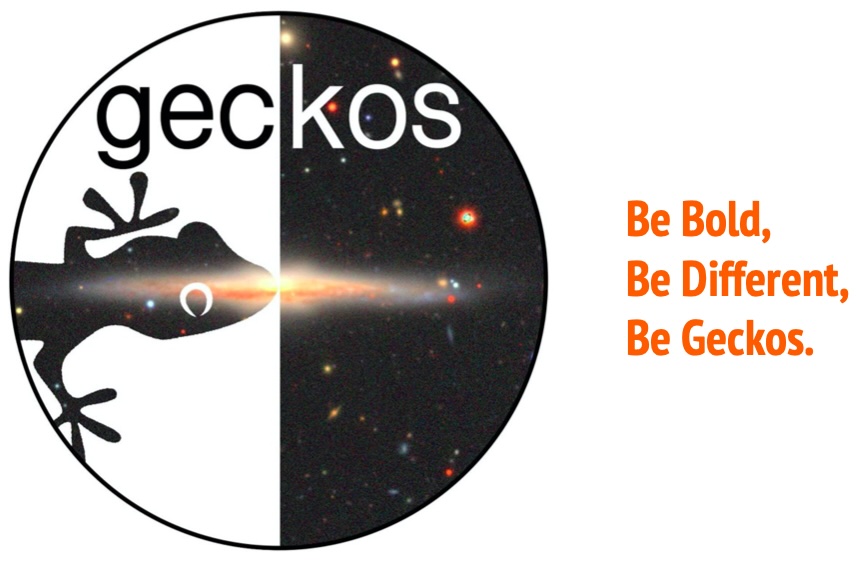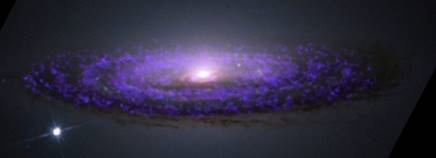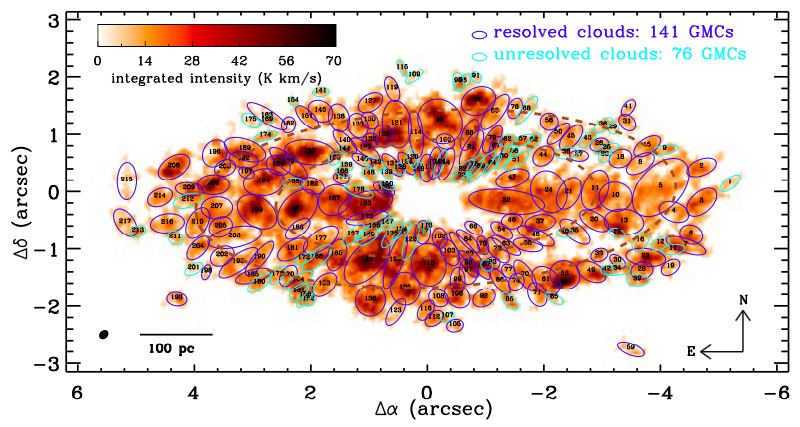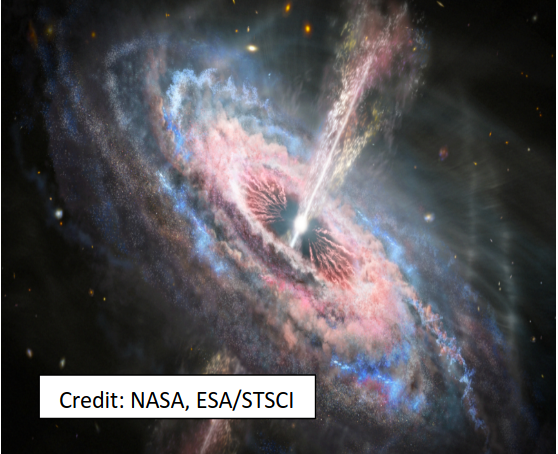A Bayesian understanding of the radio Universe
Supervisor: Matt Jarvis
The last few years has seen a step change our capability for measuring the 21cm emission line of neutral hydrogen and the radio continuum emission from star-forming galaxies and AGN. This is a result of the new generation of sensitive radio telescopes, and in particular the MeerKAT telescope in South Africa.
This brings HI astronomy into the era of large statistical surveys, with data that can both detect large numbers but also have high enough resolution to study them in detail. In this project, the student will have the opportunity to lead the work on extracting the maximum amount of information from these new surveys in order to understand the role that pristine neutral gas plays in the evolution of galaxies, and trace how it may fall along the filamentary cosmic highways onto galaxies, thus replenishing their gas supply. The student will have the opportunity to use data from the MIGHTEE Survey (PI Jarvis) and the LADUMA survey, both using MeerKAT, and the DINGO survey using ASKAP, to carry out this research. They will combine this cutting-edge data with optical and near-infrared data from Rubin/LSST, Euclid and the 4MOST spectroscopic surveys to understand how the gas relates to the stars that are already in place and the environments in which they reside.
This is an ideal project for someone to get experience of large multi-wavelength surveys and develop statistical expertise to understand galaxies and the large-scale structure of the Universe, whilst working within a large, friendly and diverse group in Oxford.
References:
- Overview of the MIGHTEE survey https://arxiv.org/pdf/1709.01901
And the data https://arxiv.org/pdf/2409.17713 - Some of the science: https://arxiv.org/pdf/2506.11935
- And the technique: https://arxiv.org/pdf/1907.10404, https://arxiv.org/pdf/2012.09797
Disentangling Galactic Bars and Bulges
Supervisor: Martin Bureau
This project aims to decipher the intricate structure of bulges, the bright and compact ensembles of billions of stars ruling the centres of galaxies. Bars in particular are known to spontaneously buckle and create bulges that are boxy and peanut-shaped when see edge-on. Bars also create shocks and thus gas flows toward the galaxy centres. In turn, classic axisymmetric spheroid models should not fit the data. By combining state-of-the-art 3D observations of the stars, ionised gas, and molecular gas, the student will first isolate individual components to probe their nature, second combine those observations with numerical models of bulges to rule out axisymmetry, and third look for bar signatures in the ionised-gas and molecular gas kinematics. The student will thus directly constrain the 3D structure and dynamics of bulges, unraveling the closely intertwined evolution of bulges and bars in galaxies.

The student will be part of the GECKOS project (be bold, be different, be GECKOS!), a deep <em>and<\em> high-resolution survey of the stars and ionised-gas of 35 nearby edge-on disk galaxies. GECKOS is based on a guaranteed-time large programme utilising the MUSE optical integral-field spectrograph on the Very Large Telescope (VLT), the premier instrument of its kind in the world, but it also includes a number of ancillary surveys, primarily with ALMA (millimeter synthesis observation). It has a number of complementary scientific aims, and while the student will be expected to focus on the issues above, participating in any and all activities of the team is possible. Extended working visits to other team members will be encouraged. This project is particularly suited to a student with an interest in observational astronomy and galaxies (structure, dynamics, interstellar medium, stellar populations, evolution).
Weighing Supermassive Black Holes Near and Far
Supervisor: Martin Bureau
Understanding the formation and evolution of galaxies is central to much of contemporary astrophysics. The relations between black hole mass and various galaxy properties imply a tight connection between the growth of central supermassive black holes (SMBHs) and that of galaxies, and these relations now underlie a staggering number of observations and simulations. However, the number of reliable SMBH mass measurements is small, and the number of independent measuring methods even smaller. A team led by Prof Bureau has shown that the kinematics of the molecular gas of galaxies is the best tracer of their of their masses (fastest and most accurate measurements). It is thus time to scale up those efforts and renew our knowledge of SMBHs.

As part of the WISDOM team (mm-Wave Interferometric Survey of Dark Object Masses), the student will use the Atacama Large Millimeter/submillimeter Array (ALMA), the largest ground-based telescope project in existence, to pursue a programme of SMBH mass measurements in a large sample of local galaxies spanning a range of morphological types, masses, and nuclear activities. There are already much data in hand, and the tools necessary to model the data and estimate uncertainties have already been developed, so the student will exploit a well-oiled machinery to make multiple measurements and explore how SMBH masses and galaxy properties correlate. The student will also help develop tools to combine this machinery with strong gravitational lensing (i.e. apply them to strongly lensed galaxies), to allow reliable SMBH mass measurements beyond the local universe to high redshifts for the first time. The project will thus significantly increase the number of reliable SMBH masses available locally while yielding the first distant measurements, and it will revolutionise our understanding of SMBH - galaxy co-evolution. This project is particularly suited to a student with an interest in observational astronomy and galaxies (structure, dynamics, nuclear activity, evolution).
Unraveling Giant Molecular Clouds and Star-formation Quenching
Supervisor: Martin Bureau
Understanding how interstellar gas turns into stars is arguably the greatest remaining puzzle in galaxy formation. Stars form in dense gas clouds known as giant molecular clouds (GMCs), but how these emerge, what their structure is, or even whether they are long-lived or transient remains unclear. Previously restricted to our own Milky Way and nearby late-type (i.e. spiral) galaxies, a new generation of telescopes now allows studies of GMCs to take an immense leap forward. By probing more diverse galaxies and hitherto inaccessible environments, new laboratories to study star formation are now available.

As part of the WISDOM team (mm-Wave Interferometric Survey of Dark Object Masses), the student will use the Atacama Large Millimeter/submillimeter Array (ALMA), the largest ground-based telescope project in existence, to study GMC populations in a large sample of galaxies spanning a range of morphological types, masses, and nuclear activities. There are much data in hand already, and the project aims to refine and develop the tools required to characterise individual GMCs and thus infer the properties of entire GMC populations. In particular, the student will probe individual clouds orbiting supermassive black holes (SMBHs) deep within spheroids, measuring their sizes, luminosities, and dynamics, and constraining their evolutionary histories. This is essential to establish whether the properties of GMCs are universal, or whether they are affected by the SMBHs and galaxy properties, in turn impacting their ability to form stars or otherwise feed the SMBHs. By significantly increasing the number of galaxies with GMC censuses, the project will revolutionise our understanding of GMC formation and evolution. This project is particularly suited to a student with an interest in observational astronomy and galaxies (structure, dynamics, interstellar medium, star formation, evolution).
Feeding and feedback processes in Active Galactic Nuclei across cosmic time
Supervisors: Dimitra Rigopoulou, Niranjan Thatte
Active galactic nuclei (AGN) – galaxies hosting accreting supermassive black holes (SMBH) – release enormous amounts of energy that dramatically impacts the surrounding environment. This energy interacts with the interstellar medium (ISM) of the host galaxy, driving powerful outflows which play a critical role in regulating the galaxy’s star formation (SF) through so-called feedback mechanisms. This feedback can either suppress SF by removing or heating the gas (preventing it from further collapse) or promote SF by compressing the gas (and facilitating its collapse to form stars). Either way, feedback is key in shaping the properties of their host galaxies.
 Although, feedback determines how black holes influence galaxies, feeding determine how galaxies influence their black holes. Gas must lose angular momentum to be accreted by the SMBH. This process can be driven by galaxy mergers, bars, or disk instabilities that funnel material into the central few hundred parsecs. Galaxy interactions and mergers are especially effective at driving gas inward, often triggering bursts of star formation and rapid SMBH growth.
Although, feedback determines how black holes influence galaxies, feeding determine how galaxies influence their black holes. Gas must lose angular momentum to be accreted by the SMBH. This process can be driven by galaxy mergers, bars, or disk instabilities that funnel material into the central few hundred parsecs. Galaxy interactions and mergers are especially effective at driving gas inward, often triggering bursts of star formation and rapid SMBH growth.
The James Webb Space Telescope (JWST) is transforming our understanding of galaxy evolution, by enabling a detailed look at the mechanism by which the central SMBH influences its host galaxy. Using MIRI-MRS and NIRSpec-IFU spectra, as well as ALMA observations the successful DPhil candidate has a choice between two strands investigating feeding/feedback locally and at Cosmic Noon
Option 1: Feedback processes in Local AGN: The obscuring torus is a pivotal component in the feeding and feedback processes of AGN. Our best chance of studying this dusty structure and its impact on the surrounding ISM is through observations of local AGN at infrared wavelengths. So far, our team has been able to establish the dramatic impact of the SMBH on the host galaxy through JWST observations of a sample of local AGN. But what is the link between SMBH mass/luminosity and feedback? Do outflows promote or shutdown SF?
In nearby AGN most of the action takes place within the innermost 100 pc, which corresponds to a fraction of an arc-second in the nearest galaxies. As part of this project, we are looking to develop a novel technique to disentangle the AGN light from the galaxy’s emission and absorption features in the innermost arcsecond, through forward modelling of the JWST point-spread function (PSF). This technique will allow us to study a range of novel diagnostics present in JWST spectra, at scales matching that of the AGN torus. By modelling emission and absorption features, we will seek to determine the key properties of the gas and search for kinematic signatures of in- or outflowing gas within the innermost nuclear region.
Option 2: Feeding and Feedback processes at Cosmic Noon: Cosmic noon represents the peak in star-forming activity and SMBH growth in the Universe and therefore is a crucial period for understanding the role of AGN in galaxy evolution. Powerful AGN driven outflows appear ubiquitous in AGN at cosmic noon. But what are their key characteristics, geometrical configuration, outflow mass-rates and kinetic power? How does the ISM of the host-galaxy (electron density and temperature, ionization state, and metallicity) respond to such powerful outflows?
Using proprietary JWST NIRSpec and MIRI-MRS spectra (Cycles 4 &5) of a sample of powerful AGN with evidence for strong outflows, this project will explore novel diagnostics to constrain the impact of the AGN on its host galaxy at a critical time in galaxy evolution. As part of this project, we are looking to develop an advanced 3D kinematic modelling tool to reconstruct the (de-projected) geometry of large-scale, biconical outflows. This approach will provide key insights into outflow dynamics that were previously inaccessible at high-z.
References (please contact the supervisors for an extended reading list):
- Polycyclic aromatic hydrocarbon emission in galaxies as seen with JWST, Rigopoulou+24, MNRAS, 532, 1598
- The Galaxy Activity, Torus, and Outflow Survey (GATOS). V: Unveiling PAH survival and resilience in the circumnuclear regions of AGN with JWST Garcia-Bernete,, 2024, A&A, 691, 162
Grasping the glow: investigating the power behind circum-galactic medium emission
Supervisors: Julien Devriendt, Adrianne Slyz
Low density gas streams along networks of filaments in the intergalactic medium (IGM) until it is funnelled through the circum-galactic medium (CGM). This latter then feeds galaxy growth by replenishing their fuel supply, allowing star formation to proceed deep into the interstellar medium (ISM). In doing so, it mixes with gas ejected by supernovae, stellar winds, and supermassive black hole jets. Most observational studies rely on detecting the CGM in absorption along the line of sights of bright quasars located behind the host galaxy or by looking at the host galaxy itself down-the-barrel. As a result, each observation is limited to one sightline per galaxy, and although statistical studies have yielded some information, they still only hint at the characteristics of the CGM. However, a new generation of instruments is preparing to detect the CGM in emission. This groundbreaking step will allow the direct mapping of extended gaseous haloes around galaxies, leading to measurements of the amount of CGM gas in different phases, their cooling times, and thus, ultimately, their fate.

For this project, the DPhil student will perform numerical studies of the CGM within the explicit framework of a cold dark matter dominated Universe, using the adaptive mesh refinement hydrodynamics code RAMSES-RTZ (Katz 2022). This code couples a complex non-equilibrium chemical network to radiative transfer, making it one of the only ones in the world capable to accurately predict emission from the CGM. Such theoretical work is crucial to motivate observations particularly because the CGM gas is low density and thus notoriously difficult to detect. Starting with the MEGATRON suite of cosmological simulations (see references below) performed with RAMSES-RTZ and including tracer particles to follow the Lagrangian evolution of fluid parcels, the student will analyse the CGM emission of high redshift galaxies, looking to understand its dynamics and properties as a function of star formation, environment, etc. In a second stage, they will move on to designing and running their own high-resolution simulations of galaxy formation, adding supermassive black holes, and/or magnetic fields, and/or cosmic rays, components which are missing from the original MEGATRON simulations. Scientific goals include assessing which combinations of emission lines best trace the spatial distribution of the multi-phase CGM at different redshifts, determining distances out to which there is detectable CGM emission and through which lines, pinning down the origin of dense gas in the CGM (inflow or outflow?), and, more generally, shedding light on how the CGM of different galaxies interfaces both with the IGM and ISM on larger and smaller scales respectively.
The DPhil student will be part of an international collaboration (US, France, South Korea, UK) developing and exploiting state-of-the-art, high-resolution, and physics rich cosmological simulations.
References:
- Cadiou et al., “MEGATRON: The impact of non-equilibrium effects and local radiation fields on the circum-galactic medium at cosmic noon”, arXiv:2510.05667
- Choustikov et al., “MEGATRON: Disentangling physical processes and observational bias in the multi-phase ISM of high redshift galaxies”, arXiv:2510.06347
- Katz et al., “MEGATRON: Reproducing the diversity of high redshift galaxy spectra with cosmological radiation hydrodynamics simulations”, arXiv:2510.05201
- Katz, H. “RAMSES-RTZ: non-equilibrium metal chemistry and cooling coupled to on-the-fly radiation hydrodynamics”, 2022, MNRAS, 512, 348
- Rodriguez Montero, F. et al., 2024, The impact of cosmic rays on the interstellar medium and galactic outflow of Milky Way analogues”, MNRAS, 530, 3617
- Vargas et al., 2025, “Pioneering far UV emission mapping of the circumgalactic medium with Aspera—motivation, mission status, and lessons learned”, Journal of Astronomical Telescopes, Instruments, and Systems, 11, 4, 042216
Small worlds from other stars: Interstellar Objects from the Rubin Observatory
Supervisors: Chris Lintott, Michele Bannister (University of Canterbury, NZ)

Interstellar objects — small bodies flung free from distant solar systems, detected on their way through ours — provide a unique opportunity to study the process of planetesimal formation across the galaxy, to test our understanding of the Milky Way’s history and dynamics, and may have played a crucial role in forming the planets. The recent arrival of 3I/ATLAS - the third interstellar object to be detected and likely the oldest thing seen in the solar system - has demonstrated the potential of our Ōtautahi-Oxford model (Lintott et al 2022; Hopkins et al. 2023, 24) to predict the properties of such objects, and to use them to understand the history of the galaxy.
The upcoming Vera Rubin Observatory’s optical LSST survey (first light 2025) and NASA NEOSurveyor infrared space telescope (first light 2027) will provide a rich harvest of such objects. This DPhil provides an opportunity to get involved in all aspects of the study of ISOs, from extending the chemistry and dynamics of our model, to survey simulation and operation, as well as ample observational follow-up with major telescopes including CFHT.
Given that studying ISOs involves understanding the chemical evolution of the Milky Way, planetesimal formation, galactic dynamics and the chemistry and behaviour of small bodies, the project would suit a student with broad interests and a willingness to learn. Travel to New Zealand and to observatories is also a strong possibility.
Unveiling the nature of dark matter with Euclid, Rubin and MeerKAT
Supervisors: Matt Jarvis, Tariq Yassin, Harry Desmond (Portsmouth)
Most of the matter in the universe is a mysterious substance called dark matter. Two of the main ways to learn about dark matter are galaxy dynamics, the motions of the stars and gas in galaxies, and weak lensing, the bending of light by mass. In this project we will test the nature of dark matter by constructing cutting edge methods to constrain the dark matter distribution around galaxies and applying them to the exciting new datasets arriving over the course of the PhD from the Euclid and SKA observatories.
We will begin by creating a framework that combines lensing and kinematic information to map how visible matter relates to the underlying dark matter density field, and to quantify whether there are systematic patterns in this connection — in particular, how strongly the distribution of visible matter can predict the distribution of dark matter. Previous studies have found evidence for a surprisingly tight relationship between these components called the radial acceleration relation (e.g. [1], [2]), but its physical origin and universality remain poorly understood. Investigating this connection in detail will provide a powerful test of models of galaxy formation and of the fundamental properties of dark matter. Building on this, we will develop Bayesian forward models [3] to assess how well current theoretical frameworks reproduce the observed trends, and to identify whether additional physical ingredients or alternative dark matter scenarios are needed to explain them.
Having learnt the correlations between dark matter and galaxy properties, we will then develop novel causal discovery methods (hitherto barely applied in astrophysics and cosmology) to uncover the causal structure of their interrelation. Whereas traditional analyses rely on statistical associations, causal discovery algorithms can determine which variables directly influence others, the direction of those influences, and whether latent confounders are required to explain the observed dependencies [4]. This will provide additional, previously untapped constraining power into the physical mechanisms at play.
References:
- [1] A. Vărăşteanu, M. Jarvis et. al “MIGHTEE-HI: the radial acceleration relation with resolved stellar mass measurements”, MNRAS 541, 2366 (2025)
- [2] T. Mistele et al, “Radial acceleration relation of galaxies with joint kinematic and weak-lensing data”, JCAP 04 020 (2024)
- [3] Trotta, Robert, “Bayes in the Sky”, Contemporary Physics 49(2), 71-104 (2008)
- [4] H. Desmond & J. Ramsey, “The causal structure of galactic astrophysics”, MNRAS submitted (arXiv:2510.01112)

